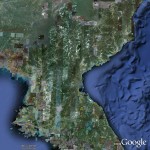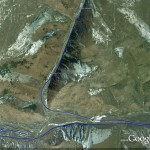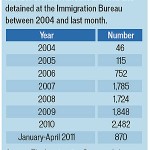
Pictured above: Locations of Koryolink (Orascom) moblie phone towers I have identified in the DPRK. Supposedly 300 exist in total.
The German Financial Times published a story on Orascom. Much of it was familiar material, but it did contain one interestign nugget I had not seen before:
Etwa 20 Ägypter und mehr als 200 Nordkoreaner arbeiten für Koryolink – die meisten der Expats im Management, ein Großteil der Nordkoreaner als Techniker und im Service. Für die Kundenbetreuung wurde ein modernes Callcenter eingerichtet. Das Netz deckt die Großstädte, die Autobahnen und die Schienenwege ab, insgesamt etwa 15 Prozent der Staatsfläche. In dem Gebiet leben 91 Prozent der Bevölkerung.
And putting this through Google Translate we get:
Throughout the country, told Heikal, meanwhile, more than 300 transmitters spread. Some 20 Egyptians and more than 200 North Koreans work for Koryolink – most of the expatriates in management, the majority of North Koreans as a technician and service. For customer support a call center was established. The network covers the major cities, highways and rail lines, totaling about 15 percent of state land. In the field 91 percent of the population live.
The service has grown to over 500,000 users but still remains out of the hands of the vast majority of the population:
Auch wenn jetzt theoretisch jeder ein Handy haben darf, sind die Tarife für die meisten Nordkoreaner unbezahlbar. 200 Freiminuten und 20 SMS kosten im Monat 800 nordkoreanische Won, nach offiziellem Wechselkurs sind das rund 5,50 Euro. Dazu kommen die Freischaltgebühr und die SIM-Karte für 50 Euro – zahlbar in Devisen. Wer sich nichts in der wuchernden Schattenökonomie dazuverdient, kann sich das nicht leisten.
And again, via Google Translate:
Even though now may theoretically have a cell phone each, the rates for most North Koreans are priceless. 200 free minutes and SMS cost 20,800 North Korean won per month, according to the official exchange rate is around 5.50 €. Then there are the activation fee and the SIM card for € 50 – payable in foreign currency. Anyone who does nothing, earned in the sprawling shadow economy can not afford that.
And on the human resources front…
Auch bei seinen nordkoreanischen Mitarbeitern bemerkt er Veränderungen. “Vom technischen Können her sind sie sehr gut, die Herausforderungen lagen eher im kaufmännischen Bereich und im Marketing”, sagt Heikal. “Aber wir bilden sie im Unternehmen aus, und wir organisieren für sie Trainings im Ausland, vor allem in China. Ich spüre, dass sich ihre Mentalität über die vergangenen drei Jahre gewandelt hat. Sie beginnen, das Geschäft zu kapieren.”
Bisher sind nordkoreanische Angestellte noch nicht ins oberste Management vorgestoßen, aber mittelfristig sollen sie die ägyptischen Expats ablösen. Natürlich wünscht sich das Regime, dass die eigenen Leute dort die Verantwortung übernehmen – und hegt trotzdem, wie so oft, schwere Bedenken dagegen. “Auf der Managementebene muss man mit der Außenwelt kommunizieren”, gibt Heikal zu bedenken. “Wir diskutieren das mit den Behörden. Sie verstehen das Problem, aber ich denke, das wird noch etwas dauern.” Er lächelt. “Im Rückblick erkennt man enorme Verbesserungen und Veränderungen, aber wir haben noch viel vor uns. Eine ganze Reihe von Dingen wird noch eine Menge Geduld brauchen.”
via Google Translate:
Even with his North Korean employees, he noticed changes. “From her technical ability, they are very good, the challenges were more in the commercial sector and in marketing,” says Heikal. “But we are training in the company, and we’ll arrange for her training abroad, especially in China. I feel that their mentality has changed over the past three years. You begin to understand the business.”
So far North Korea’s workers are not pushed into top management, but the medium they are to replace the Egyptian expatriates. Of course, the regime hopes that their own people over there take the responsibility – and still cherishes, as so often, serious concerns about it. “At the management level needs to communicate with the outside world is,” says Heikal pointed out. “We discuss with the authorities. You understand the problem, but I think it will take some time.” He smiles. “In retrospect, there are vast improvements and changes, but we still have a lot to us. A whole series of things still need a lot of patience.”
Read the full story here:
Die Pyramidenbauer von Pjöngjang
German Financial Times
2011-5-8



